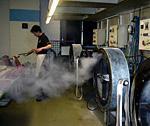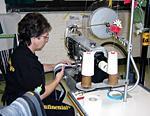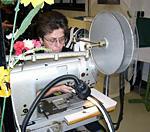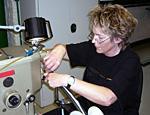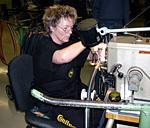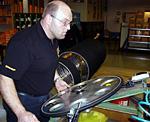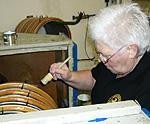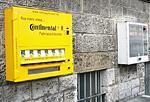
Recently on Cyclingnews.com |
Tech feature: Inside Continental's tyre factory, June 17, 2005All stitched upContinental's bicycle tyre division is a small part of what's now a huge company, but it's where the German rubber started out, and Conti is still fiercely dedicated to making bike tyres - as are its employees. Gerard Knapp met some of the people who craft Continental's tyres, and found out what goes into a hand-made tubular and why they're still the pro's choice. The paved, well-worn flooring rumbles underfoot, the mechanical clatter is so loud that hearing protection is required, giant steel rollers hiss with steam as they compress mysterious, raw black compounds into wide thin layers. And then there's the smell - the odour of baking rubber is over-whelming, carried by the high relative humidity and penetrating the nasal cavities so it remains for days after. You look around as burly men wearing rubberized aprons wheel large pallets of mysterious black materials among the giant machinery. Welcome to a tyre factory. I had waited some time for this, ever since seeing Fritz Lang's classic B&W silent science fiction film, Metropolis. I'd visited many factories, but none had ever captured the scale, sight, smell and sound of Continental's factory in Korbach, Germany.
Given it was built around the same time as Lang made his film - at the height of the industrial boom in Europe - it's not surprising, but unlike Lang's film, there is no worker revolt. Indeed, it's something of the opposite as the company has employees with decades of service, still producing tyres for the company. The production of bicycle tyres is at the root of Continental's foundation. The company started business making bicycle tyres, even if the bicycle tyre department is now one of the smallest divisions of the German conglomerate. Nonetheless, the company is extremely proud of its heritage, as well as the service and expertise of its employees. Many of you may have seen the striking monochrome advertisements and marketing materials that Continental has released over the past 12 months, focusing on these extraordinary employees at its Korbach factory, nestled away, as they are, in this enormous complex that also produces motorcycle and some car tyres (Conti has other factories in Germany). The bicycle tyre specialists work in a somewhat more pleasant environment, two floors above the ground-floor raw materials engine room. But it was this combination of environment, people and expertise that struck senior Continental marketing executive, Jorg Malcherek, when he went to the Korbach factory. He thought of these typically German qualities as strengths, so he built a marketing campaign around them. He brought in pros like T-Mobile's Eriz Zabel and Credit Agricole's Thor Hushovd to pose in the factory with the (somewhat overwhelmed) workers who produce every tubular tyre that Continental sells around the world. (Zabel, in particular, was said to be very popular among the workers.) I suspect that for many readers, the whole 'tubulars experience' is foreign, but every cyclist should experience riding on a set at least once in their cycling life. No matter how good 'clincher' tyres have become, and they're very good, nothing beats a set of tubulars (and we have science to back this up, too). But for most of us that have used tubulars for any length of time, a flat is not fun; they're buggers to fix. (Quick quiz: what is the number one reason many professional riders still largely insist on using tubular tyres? Answer: Their 'run-flat' ability. That is, a tubular can go flat and it is still possible to ride on the wheel, at least until the rider is in a better position to receive service. Of course, this will probably damage the rim and tyre almost beyond repair, but in a race environment, such collateral damage is acceptable. If a clincher tyre goes flat, it is very dangerous indeed to keep riding, as the tyre can be dislodged from the rim and then all hell breaks loose as it wraps itself around the wheel. But because tubulars are glued to the rim - and we mean glued - they remain in one piece. Hence their antipodean nickname - singles.) Back to repairing them. It is when your prized tubular gets a puncture you appreciate the work that goes into making one. After removing it from the rim (gorilla-strength required. Okay, that's an exaggeration - but only a slight one) you have to locate the puncture by time-honoured method of pumping up the tyre as quickly as possible and dunking it in a bucket of water to find the bubbles. Then you remove a base layer tape (again - glued) and the casing is revealed, which is stitched together very neatly. Then, you unpick the stitching to access the inner tube, patch the hole, and cross your fingers you've done a good job. That's because you have to stitch the casing back up with industrial-thick needle and thread - and this is an art in itself, as you need to ensure the casing remains aligned and your tyre doesn't go out-of-shape. Then you re-inflate the tyre, and hope it doesn't go flat again. If it holds air okay, you can then re-glue the base tape. Then you have to glue it back to the rim. By now, you're probably saying "why bother?" Indeed, that's why modern clinchers are a revelation, but what clinchers can't do is offer the same comfort, feel, lower rolling resistance and run-flat capability of tubulars. I've always thought of tyres (and wheels, to some extent) as being like loudspeakers to a hi-fi system; there is no easier way to improve your enjoyment than spending up on good wheels and tyres.
And for this reason, there is still a market for the very best cycling tyres you can buy. Continental takes immeasurable pride in their product and it is hard to think of any other piece of the highest-end cycling kit where you can learn the names of the core group of four women who make every one of them. They are: Maria Stolz, Androniki Mpontia, Barbel Disterheft and Margit Halle. And as a hapless repairer of tubulars in the past, I dips my lid. Love your work. See also: Vectran keeps Conti inflated - Conti talks tyre tech |



